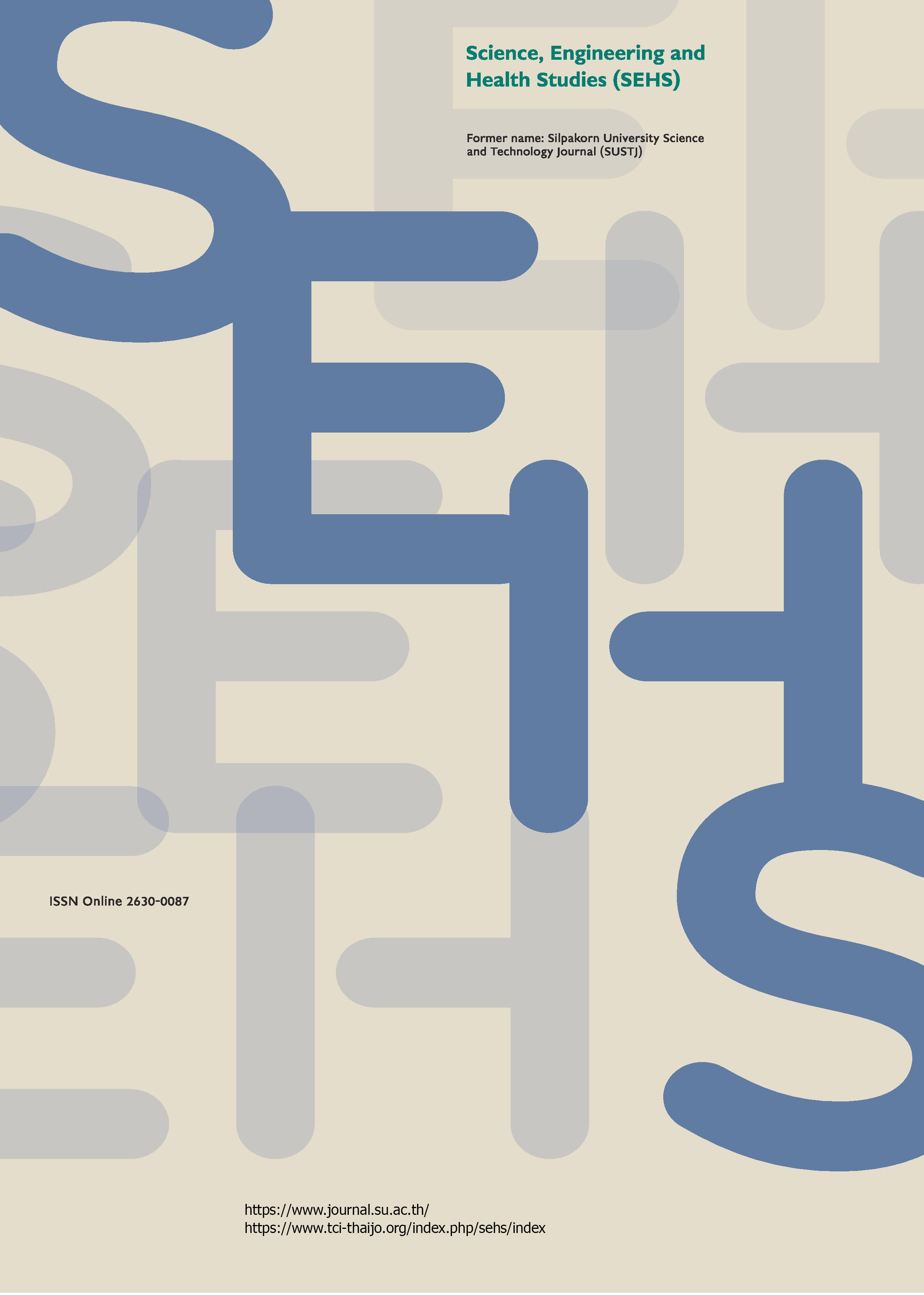Quality improvement of gluten-free doughnuts by using hydrocolloids
Main Article Content
Abstract
Gluten-free foods are alternative products for consumers who have wheat gluten allergies, a symptom of celiac disease. However, replacing wheat with gluten-free flour usually results in the loss of some quality attributes of products. Hydrocolloids are widely used to improve the characteristics of gluten-free products. In this study, response surface methodology was applied to analyze the effect of hydrocolloids, including xanthan gum, carboxymethyl cellulose (CMC), and hydroxypropylmethyl cellulose (HPMC), on the physical and sensory properties of gluten-free yeast doughnuts. The flour base of gluten-free doughnuts contained jasmine rice flour, buckwheat flour, and corn flour at a weight ratio of 50:30:20, respectively. A face-centered central composite design with three hydrocolloids treated as independent variables was utilized to investigate their effects on the doughnuts’ physical and sensory characteristics. Each of the hydrocolloids was set at a concentration range of 0-1 g/100 g. Results revealed that adding xanthan gum improved the mass change, moisture content cohesiveness, and chewiness of gluten-free doughnuts. HPMC helped improve the volume change and moisture content, and CMC enhanced the texture of gluten-free doughnuts. The combination of the three hydrocolloids at weight ratios of 0.5:0.5:0.5 and 1:1:1 significantly improved gluten-free doughnuts compared with the control and commercial products as indicated by their sensory scores and microstructure (p<0.05).
Downloads
Article Details
References
AACC International. (2000). Approved methods of the American Association of Cereal Chemists, 10th, St. Paul, Minnesota: American Association of Cereal Chemists.
AOAC. (1995). Official Method of Analysis of AOAC International. 17th. Arlington, Virginia: The association of Official Analytical Chemists.
Burešová, I., Masaříková, L., Hřivna, L., Kulhanová, S., and Bureš, D. (2016). The comparison of the effect of sodium caseinate, calcium caseinate, carboxymethyl cellulose and xanthan gum on rice-buckwheat dough rheological characteristics and textural and sensory quality of bread. LWT-Food Science and Technology, 68, 659-666.
Catassi, C., and Fasano, A. (2008). Celiac disease. In Gluten-Free Cereal Products and Beverages. (Arendt, E. K., and Bello, F. D., eds.), 1st, pp. 1-5. San Diego, California: Academic Press.
Gujral, H. S., Guardiola, I., Carbonell, J. V., and Rosell, C. M. (2003). Effect of cyclodextrin glycosyl transferase on dough rheology and bread quality from rice flour. Journal of Agricultural and Food Chemistry, 51(16), 4846-4846.
Hager, A. S., Wolter, A., Czerny, M., Bez, J., Zannini, E., Arendt, E. K., and Czerny, M. (2012). Investigation of product quality, sensory profile and ultra-structure of breads made from a range of commercial gluten-free flours compared to their wheat counterparts. European Food Research and Technology, 235(2), 333-344.
Hager, A., and Arendt, E. K. (2013). Influence of hydroxypropylmethyl cellulose (HPMC), xanthan gum and their combination on loaf specific volume, crumb hardness and crumb grain characteristics of gluten-free breads based on rice, maize, teff and buckwheat. Food Hydrocolloids, 32(1), 195-203.
Hischenhuber, C., Crevel, R., Jarry, B., Makis, M., Moneret-vuatrin, D. A., Romano, A., Troncone, R., and Ward, R. (2006). Safe amounts of gluten for patients with wheat allergy or coeliac disease. Alimentary Pharmacology and Therapeutics, 23(5), 559-575.
Kim, J., Choi, I., Shin, W., and Kim, Y. (2015). Effect of HPMC (Hydroxypropyl methylcellulose) on oil uptake and texture of gluten-free soy donut. LWT-Food Science and Technology, 62(1), 620-627.
Lazaridou, A., Duta, D., Papageorgiou, M., Belc, N., and Biliaderis, C. G. (2007). Effects of hydrocolloids on dough rheology and bread quality parameters in gluten-free formulations. Journal of Food Engineering, 79(3), 1033-1047.
Liu, X., Mu, T., Sun, H., Zhang, M., Chen, J., and Fauconneir, M. (2018). Influence of different hydrocolloids on dough thermo-mechanical properties and in vitro starch digestibility of gluten-free steamed bread based on potato flour. Food Chemistry. 239, 1064-1074.
Mariotti, M., Pagani, M. A., and Lucisano, M. (2013). The role of buckwheat and HPMC on the breadmaking properties of some commercial gluten-free bread mixtures. Food Hydrocolloids. 30(1), 393-400.
McCarthy, D. F., Gallagher, E., Gormley, T. R., Schober, T. J., and Arendt, E. K. (2005). Application of response surface methodology in the development of gluten-free bread. Cereal Chemistry, 82(5), 609-615.
Melito, H., and Farkas, B. E. (2013). Physical properties of gluten-free donuts. Journal of Food Quality, 36(1), 32-40.
Mir, S. A., Shah, M. A., Naik, H. R., and Zargar, I. A. (2016). Influence of hydrocolloids on dough handling and technological properties of gluten-free breads. Trends in Food Science and Technology, 51, 49-57.
Mohammadi, M., Sadeghnia, N., Azizi, M., Neyestani, T., and Mortazavian, A. M. (2014). Development of gluten-free flat bread using hydrocolloids: Xanthan and CMC. Journal of Industrial and Engineering Chemistry, 20(4), 1812-1818.
Ozkoc, S. O., Sumnu, G., and Sahin, S. (2009). The effects of gums on macro and micro-structure of breads baked in different ovens. Food Hydrocolloids, 23(8), 2182-2189.
Puerta, P., Laguna, L., Villegas, B., Rizo, A., Fiszman, S., and Tarrega, A. (2020). Oral processing and dynamics of texture perception in commercial gluten-free breads. Food Research International, 134, 109233.
Rosell, C. M., and Marco, C. (2008). Rice. In Gluten-free cereal products and beverages (Arendt, E.K. and Bello, F. D., eds.), 1st, pp. 81-91. San Diego, California: Academic Press.
Sabanis, D., and Tzia, C. (2011). Selected structural characteristics of HPMC containing gluten-free bread: a response surface methodology study for optimizing quality. International Journal of Food Properties, 14(2), 417-431.
Shih, F. F., Daigle, K. W., and Clawson, E. L. (2001). Development of low oil-uptake donuts. Journal of Food Science, 66(1), 141-144.
Turabi, E., Sumnu, G., and Sahin, S. (2010). Quantitative analysis of macro and microstructure of gluten-free rice cakes containing different types of gums baked in different ovens. Food Hydrocolloids, 24(8), 755-762.


